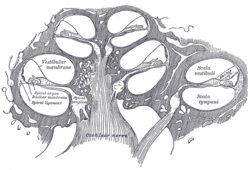- Cochlear nerve
-
Nerve: Cochlear nerve 
Diagrammatic longitudinal section of the cochlea. (Cochlear nerve is in center, shown as striped.) 
Part of the cochlear division of the acoustic nerve, highly magnified. Latin nervus cochlearis Gray's subject #203 906 From Vestibulocochlear nerve MeSH Cochlear+Nerve The cochlear nerve (also auditory or acoustic nerve) is a nerve in the head that carries signals from the cochlea of the inner ear to the brain. It is part of the vestibulocochlear nerve, the 8th cranial nerve which is found in higher vertebrates; the other portion of the 8th cranial nerve is the vestibular nerve which carries spatial orientation information from the semicircular canals. The cochlear nerve is a sensory nerve, one which conducts to the brain information about the environment, in this case acoustic energy impinging on the tympanic membrane. The cochlear nerve arises from within the cochlea and extends to the brainstem, where its fibers make contact with the cochlear nucleus, the next stage of neural processing in the auditory system.
Contents
Anatomy and connections
In terms of their anatomy, auditory nerve fibers are bipolar, with the most distal portion being called the peripheral process and the central projection being called the axon; these two projections are also known as the "peripheral axon" and the "central axon". The peripheral process is sometimes referred to as a dendrite, although that term is somewhat inaccurate. Unlike the typical dendrite, the peripheral process generates and conducts action potentials, which then "jump" across the cell body (or somata) and continue to propagate along the central axon. In this respect, auditory nerve fibers are somewhat unique bipolar cells in that action potentials pass through the soma. Both the peripheral process and the axon are myelinated.
In humans, the number of nerve fibers within the cochlear nerve averages around 30,000.[1] The number of fibers varies significantly across species—for example, the domestic cat has some 50,000 fibers. Auditory nerve fibres provide synaptic connections between the hair cells of the cochlea and the cochlear nucleus within the brainstem. The cell bodies of the cochlear nerve lie within the central aspect of the cochlea and are collectively known as the spiral ganglion. This name reflects the fact that the cell bodies, considered as a unit, have a spiral (or perhaps more accurately, a helical) shape, reflecting the shape of the cochlea. The terms "cochlear nerve fiber" and "spiral ganglion cell" are used, to some degree, interchangeably, although the former may be used to more specifically refer to the central axons of the cochlear nerve. These central axons exit the cochlea at its base, where it forms a nerve trunk. In humans, this aspect of the nerve is roughly one inch in length. It projects centrally to the brainstem, where its fibers synapse with the cell bodies of the cochlear nucleus. A good anatomical description of human auditory nerve fibers is provided by Spoendlin and Schrott (1985). Important earlier work was done by Schuknecht.
It was once believed that most of the cochlear nerve fibres were directed to the outer hair cells, but it is now understood that at least 90% of the cochlear ganglion cells terminate on inner hair cells, the rest terminating on the outer hair cells.
The transmission between the inner hair cells and the neurons is chemical, using glutamate as a neurotransmitter.
Types of neurons
The cochlear neurons can be divided into two groups: Type I and Type II.
- Type I neurons make up 90-95% of the neurons and innervate the inner hair cells. They have a relatively large diameter, and are bipolar and myelinated. Each type I axon innervates only a single hair cell, but each hair cell directs its output to an average of 10 nerve fibres
- Type II cells, which have a relatively small diameter, connect with the outer hair cells, are monopolar and are not myelinated.
Cochlear nuclear complex
The axons from each cochlear nerve terminate in the cochlear nuclear complex which are ipsilaterally located in the medulla of the brainstem. The cochlear nucleus is the first 'relay station' of the auditory nervous system and receives mainly ipsilateral afferent input.
The three major components of the cochlear nuclear complex are: (see figure below)
- the dorsal cochlear nucleus (DCN)
- the anteroventral cochlear nucleus (AVCN)
- the posteroventral cochlear nucleus (PVCN)
Each of the three cochlear nuclei are tonotopically organised. The axons from the lower frequency area of the cochlea innervate the ventral portion of the dorsal cochlear nucleus and the ventrolateral portions of the anteroventral cochlear nucleus, while the higher frequency axons project into the dorsal portion of the anteroventral cochlear nucleus and the uppermost dorsal portions of the dorsal cochlear nucleus. The mid frequency projections end up in between the two extremes, in this way the frequency spectrum is preserved.
See also
References
- ^ Spoendlin H, Schrott A (1989). "Analysis of the human auditory nerve". Hear Res 43 (1): 25–38. doi:10.1016/0378-5955(89)90056-7. PMID 2613564.
Additional images
External links
Auditory and vestibular pathways Auditory inner ear: Hair cells → Spiral ganglion → Cochlear nerve VIII →
pons: Cochlear nuclei (Anterior, Dorsal) → Trapezoid body → Superior olivary nuclei →
midbrain: Lateral lemniscus → Inferior colliculi →
thalamus: Medial geniculate nuclei →
cerebrum: Acoustic radiation → Primary auditory cortexVestibular inner ear: Vestibular nerve VIII →
pons: Vestibular nuclei (Medial vestibular nucleus, Lateral vestibular nucleus)
cerebellum: Flocculonodular lobe
spinal cord: Vestibulospinal tract (Medial vestibulospinal tract, Lateral vestibulospinal tract)
thalamus: Ventral posterolateral nucleus
Vestibulo-oculomotor fibersM: EAR
anat(e/p)/phys/devp
noco/cong, epon
proc, drug(S2)
Nerves of head and neck: the cranial nerves and nuclei (TA A14.2.01, GA 9.855) olfactory (AON->I) optic (LGN->II) oculomotor
(ON, EWN->III)trochlear (TN->IV) no significant branchestrigeminal
(PSN, TSN, MN, TMN->V)abducens (AN->VI) no significant branchesfacial (FMN, SN, SSN->VII) near originvestibulocochlear
(VN, CN->VIII)glossopharyngeal
(NA, ISN, SN->IX)before jugular fossaafter jugular fossavagus
(NA, DNVN, SN->X)before jugular fossaafter jugular fossaaccessory (NA, SAN->XI) hypoglossal (HN->XII) Categories:
Wikimedia Foundation. 2010.






